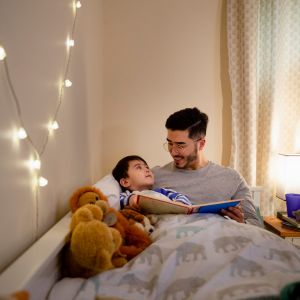How hard is it to get toddlers to sleep in their own bed?
As a mother of two little ones, I understand how exhausting night time can be.
Getting our kids ready for bed, being willing to sleep in their own beds and sleeping through the night are all challenges that many of us face as parents.
Yet, establishing good sleep habits and getting our kids to sleep in their own beds is not as complicated as it’s made out to be. I really think the key principles to achieve these goals involves: understanding your child’s needs and fulfilling them, creating good sleep habits and routines and being consistent.
In this post I’d like to share with you how I got my child sleeping in her own bed.
Without crying it out or any amount of tears at all.
I do understand that each family is different and each child is also different so it’s not a one size fits all solution.
However, I think it’s helpful to hear of other mom’s experiences to see what approaches are really working and are effective.
The approach I used was the Shuffle Method, founded by the Sleep Lady.
I think this is one of the best methods for sleep training because it doesn’t involve you leaving your child to cry it out. Instead, it focuses on teaching your child the skill of falling asleep by themselves.
It’s truly brilliant and I honestly wish I had heard of this method before and had used it with my older child.
This post is about how to get toddlers to sleep in their own bed
Ready to turn bedtime into a family affair? Let’s explore the magical steps to get your toddler to sleep in their own bed.
10 Sleep Training Steps to Effortlessly Get Toddlers to Sleep in Their Own Bed
This post contains affiliate links. As an Amazon Associate I earn from qualifying purchases at NO additional cost to you. Thank you for your support.
1. Shift from a crib to a floor bed/mattress
The first thing I did was to shift my 15 month old from a crib in our room to a floor mattress in her own room.
I really like transitioning from the crib to a floor mattress or floor bed rather than to a regular toddler bed. Floor mattresses have so many advantages for toddlers that I could go on and on about.
Some of the most important benefits include:
- you dont need to worry about your child trying to climb out of the bed and falling off and hurting themselves
- your child can get into and out of the bed herself without help which fosters independence
- your child will feel less constricted and a lot less cranky
- you can easily lie down next to your toddler when they wake up in the middle of the night and just as easily leave their bed
It’s super important to note that when moving your child to a floor bed, you have to make sure that the room is fully toddler proofed.
You can read more tips on properly toddler proofing your house over here.
2. Get a good quality mattress
Most parents are focused on getting a fancy bed for their child once transitioning them out of the crib. And yes, while I understand that toddler beds can be super cute and hard to resist buying, I’d save that money for a more worthy investment.
And that investment should go into the mattress that you get.
When researching on buying a mattress for my toddler, I was absolutely horrified when I learnt that most traditional mattresses are actually filled with harmful chemicals such as PVCs, flame retardants and polyurethane foam.
These have long term seriously harmful implications on your child’s health.
So if you are considering getting a mattress or already have a regular mattress (that is most likely filled with chemicals!) I’d encourage you to switch to an organic mattress.
This Organic 2 in 1 Kids Mattress by Naturepedic has raving reviews from parents and has won the Good Housekeeping 2021 Parenting Award.
That’s because it’s one of the only mattresses out there that’s breathable, organic PLUS WATERPROOF (this will make your life so much easier once you start potty training!)
You can check out more Naturepedic products here and see for yourself why it’s a go to brand for every parent looking for safe, non-toxic sleep solutions.
3. Establish a consistent bedtime routine
I’m sure you’ve heard it before a hundred times. It’s all about the bedtime routine. Toddlers thrive off of routines. It helps them know what to expect. And if the routine is followed consistently, their body starts preparing for sleep as soon as you start your night time routine.
Research shows that children who follow bedtime routines are more likely to go to sleep earlier, take less time falling asleep, sleep longer, and wake up less during the night.
sleepfoundation.org
It’s important to make sure that the bedtime routine is short and simple.
I’ve written previously about a bedtime routine that takes too long and what you should do to avoid making it stretch so long.
The key is to choose 3-4 elements and make sure to do them every night in the exact same order.
4. Create the right sleep environment
Once you’ve established a consistent bedtime routine, you need to create an environment in the house that’s conducive to sleep. This is essential if we want to get toddlers to sleep in their own bed.
You can start doing this an hour prior to bedtime by doing simple things. This can include dimming the lights and shutting off all electronics. The goal is to create a peaceful ambiance.
This will help your child’s mind and body calm down for the day and be more prepared for bedtime.
Just as importantly, your toddler’s room should also exude a calm and not chaotic vibe.
- Help your toddler put away all their toys before bed.
- A dim night light can be a wonderful way to create a peaceful atmosphere.
- Keeping a humidifier in the kid’s room has been crazy helpful for us; it helps my kid’s nasal passageway stay clear and sleep better through the night (this is the cool mist humidifier we use and absolutely love!).
- Blackout curtains/blinds are a must have in the summers (these portable bestselling blinds are a real hit on Amazon!). Blackout blinds will help signal to the brain that its night time and its time to sleep
You can read more about the best-selling sleep products for toddlers in this post here: 9 Incredible Products That Actually Help Promote Toddler and Baby Sleep
5. Use bedtime routine charts to create predictability
Are you struggling with bedtime stalling? Is your little one taking FOREVER to finish dinner, take a bath, brush teeth, wear pjs and hop into bed?
If you’re exhausted with all the night time drama and tantrums associated with getting your toddler ready for bed then please listen up. I had the exact same issue with my little one and it was driving me insane EVERY SINGLE NIGHT. And do you know what worked to cut out the night time tantrums by 90%?
Bedtime Routine Charts.

These have been absolutely life saving and sanity saving in our home. My toddler knows what she has to do and in what order. But more than that, she’s actually EXCITED to do all her night time tasks.

You can check out the Sweetnsour Bedtime Routine Charts here. Super adorable and featuring two cute designs, your child is gonna absolutely love these!
10 Drama-free Ways to Sleep Train Toddlers to Sleep in Their Own Bed
Okay so you’ve gotten your organic chemical free mattress, toddler proofed the room, created the right sleep ambiance, developed a consitent bedtime routine and are using bedtime routine charts to cut down on all the pre-bedtime drama.
Here’s the tricky part.
How do we get toddlers to sleep in their own bed? Once you’ve read that story book, how do you calmly walk out that door with a toddler who is contentedly snuggled into bed and isn’t screaming for you to come and sleep next to them?
I wanted to try a method that didn’t involve crying and screaming. And I didn’t mind if it took me a while as long as it worked. I started researching the different sleep training options I had and this is what I found.
There are 4 kinds of sleep training methods:
1) Cry it out ie extinction where you let your child cry it out without checking up on them
2) Controlled crying (where you let them cry it out but you keep checking up on them at intervals)
3) No cry (where you respond to every cry from your child)
4) Fading (where you minimize your child’s crying while at the same time teach them the skill of falling asleep by themselves)
Based on my goals, I knew 100% that the fading approach was the one that would suit our family the most. It also made the most sense to me.
One of the most famous fading approach is The Shuffle Method by Kim West This is the approach I used and I saw some phenomenal results in a very short time span.
Kim, widely known as The Sleep Lady, has achieved global recognition as an expert in baby and child sleep.
Her signature approach, The Sleep Lady Shuffle™, has helped countless families find gentle, personalized sleep solutions, allowing both parents and children to enjoy better rest.
The nickname “The Sleep Lady” was given to her by one of her satisfied clients.
Below are some of the steps I took to implement the Shuffle Method. If you’d like to learn more about how this gentle sleep training method works you can check out more over here:
6. Identify your child’s sleep association
So here’s what I did. I identified what sleep association we were using and then I worked towards reducing that sleep association slowly and gradually.
If you don’t know what a sleep association is, it basically refers to any behavior that your child associates strongly with going to sleep.
Whether you rock, feed, pat or sing your child to sleep, that is what they learn to associate with sleep and they can’t sleep without it.
Sleep associations are conditions that the child learns to need in order to fall asleep at bedtime (such as rocking, nursing, or lying next to a parent). These same sleep associations are then needed in order to fall back to sleep during the night.
www.nationwidechildrens.org
The goal we have is therefore to gradually reduce those sleep associations that involve us putting our child to sleep and instead the child drifting off to sleep without our intervention.
It’s important to note that this is NOT an overnight transformation that will take place. This is a skill your child will learn slowly and gradually and you need to be super patient and understanding (which, I understand is not very easy on many nights for sleep deprived parents)
7. Gradually reduce the sleep association
So I identified our sleep association. For us, it was patting. Every night, I patted my 12 month old to sleep. She couldn’t sleep until I had patted her asleep. And if she woke up in the middle of the night, she needed me to pat her to sleep again.
So i started working on this gradually. The goal was to reach a point where she didn’t need me to keep patting her. I tucked her into bed and continued to pat her.
However as she got drowsy, I just kept my hand on her back and stopped patting. If her eyes fluttered open, I would resume the patting.
Slowly after a few nights, I was able to pat her until she was drowsy and the rest of the time my hand would be on her back but i wasn’t patting any more.
A few nights later, I progressed until I was only keeping my hand on her back and there was no more patting.
8. Sit quietly next to the bed
Once I reached the stage where I no longer needed to pat her or even have my hand on her back, I continued to sit next to her floor bed. I would just sit there quietly while she closed her eyes.
I would close my eyes too so that it was clear that we weren’t going to be talking. She’d usually turn on her side and drift off to sleep while I sat next to her with my eyes closed.
9. Start moving closer to the door
Okay so now that she was sleeping without me physically patting, rocking or singing her to sleep, the next goal was to leave the room.
Again, the key is to do it slowly and to be patient.
Every night, I’d slowly inch away from her bed. I would still be sitting on the floor (the kid’s room is fully carpeted so it wasn’t uncomfortable). And each night I would slowly be moving closer and closer towards the door.
This is why this approach is called the Shuffle Method since you’re slowly trying to shuffle out of the room.
There were days she would notice me inching away and get cranky about it. So I’d return to my usual spot near her but then keep making progress towards the door the following days. I finally made it out the door!
10. Dim lights in the rest of the house
Once I was out the door I didn’t resume my normal activities. Instead, I quietly continued sitting next to the door with my eyes closed. I would usually listen to something on my headphones while I waited for my little one to doze off.
The reason why you have to do this is because your toddler will occasionally come up to check on you and maybe even ask you to come back into the room.
At this point, I would look super bored and sleepy and just tell her it’s bedtime and everyone needs to rest. If she got cranky I’d hold her hand, lead her gently back into bed without talking much and say a quick good night and come back out of the room.
If you’ve been consistently following all the steps above, you shouldn’t have a problem in her getting back into bed and drifting off to sleep herself. And that’s because you’ve (gradually) broken the sleep association and she is able to sleep herself.
I also made sure that the hallway had dim lighting so that even if my toddler stepped out of her room, the rest of the house had an environment conducive to sleep.
The Results
After a week of using the Shuffle Method, I gradually started resuming my activities. I still kept the lights dimmed, but after tucking her into bed, I was able to go to the kitchen and clear up for the night.
It’s been a year since I followed all these steps. And every night, I tuck her into bed and then come out the door and go on with my regular activities while she drifts off to sleep herself.
No tears, no protests and no drama.
Yes, sometimes she hops out of bed and asks for another hug and another goodnight kiss. But by and large, by following these steps I was able to get out of the cycle of her having to depend on me to be able to sleep.
I really hope these tips helped you!
One blog post is not enough to explain everything about this method. If you want more detailed and personalised advice on the sleep issues you are facing, head on over to check out the Sleep Lady Shuffle.
This is a world renowned sleep method that has helped over a million families find gentle, customized sleep solutions—and get some rest. I truly hope this method helps you as much as it helped me!
Sending you lots of well wishes for many peaceful nights ahead with your little one. You got this!
Don’t forget to grab these adorable bedtime routine charts with pictures to cut down on 90% of pre bedtime dramas in your house.
This post was about how to get toddlers to sleep in their own bed
Enjoyed this post? You might like to read these posts next:
6 Brilliant Hacks to Stop Your Toddler Kicking Off the Blanket
Toddler Unzipping the Sleep Sack? 7 Genius Tactics To Try
5 Expert Hacks on How to Transition Your Toddler to a Blanket
7 Super Clever Ways to Stop Your Toddler Falling Out of Bed
10 Practical Hacks to Handle Toddler Bedtime Stalling





Leave a Reply